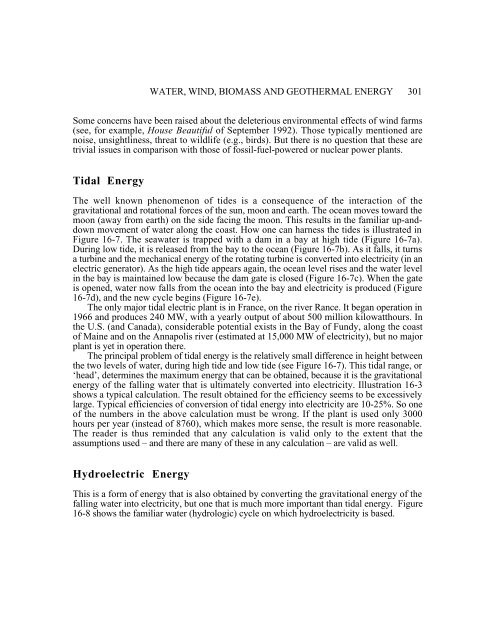Chapter 16 WATER, WIND, BIOMASS AND GEOTHERMAL ENERGY
Chapter 16 WATER, WIND, BIOMASS AND GEOTHERMAL ENERGY
Chapter 16 WATER, WIND, BIOMASS AND GEOTHERMAL ENERGY
Create successful ePaper yourself
Turn your PDF publications into a flip-book with our unique Google optimized e-Paper software.
<strong>WATER</strong>, <strong>WIND</strong>, <strong>BIOMASS</strong> <strong>AND</strong> <strong>GEOTHERMAL</strong> <strong>ENERGY</strong> 301<br />
Some concerns have been raised about the deleterious environmental effects of wind farms<br />
(see, for example, House Beautiful of September 1992). Those typically mentioned are<br />
noise, unsightliness, threat to wildlife (e.g., birds). But there is no question that these are<br />
trivial issues in comparison with those of fossil-fuel-powered or nuclear power plants.<br />
Tidal Energy<br />
The well known phenomenon of tides is a consequence of the interaction of the<br />
gravitational and rotational forces of the sun, moon and earth. The ocean moves toward the<br />
moon (away from earth) on the side facing the moon. This results in the familiar up-anddown<br />
movement of water along the coast. How one can harness the tides is illustrated in<br />
Figure <strong>16</strong>-7. The seawater is trapped with a dam in a bay at high tide (Figure <strong>16</strong>-7a).<br />
During low tide, it is released from the bay to the ocean (Figure <strong>16</strong>-7b). As it falls, it turns<br />
a turbine and the mechanical energy of the rotating turbine is converted into electricity (in an<br />
electric generator). As the high tide appears again, the ocean level rises and the water level<br />
in the bay is maintained low because the dam gate is closed (Figure <strong>16</strong>-7c). When the gate<br />
is opened, water now falls from the ocean into the bay and electricity is produced (Figure<br />
<strong>16</strong>-7d), and the new cycle begins (Figure <strong>16</strong>-7e).<br />
The only major tidal electric plant is in France, on the river Rance. It began operation in<br />
1966 and produces 240 MW, with a yearly output of about 500 million kilowatthours. In<br />
the U.S. (and Canada), considerable potential exists in the Bay of Fundy, along the coast<br />
of Maine and on the Annapolis river (estimated at 15,000 MW of electricity), but no major<br />
plant is yet in operation there.<br />
The principal problem of tidal energy is the relatively small difference in height between<br />
the two levels of water, during high tide and low tide (see Figure <strong>16</strong>-7). This tidal range, or<br />
‘head’, determines the maximum energy that can be obtained, because it is the gravitational<br />
energy of the falling water that is ultimately converted into electricity. Illustration <strong>16</strong>-3<br />
shows a typical calculation. The result obtained for the efficiency seems to be excessively<br />
large. Typical efficiencies of conversion of tidal energy into electricity are 10-25%. So one<br />
of the numbers in the above calculation must be wrong. If the plant is used only 3000<br />
hours per year (instead of 8760), which makes more sense, the result is more reasonable.<br />
The reader is thus reminded that any calculation is valid only to the extent that the<br />
assumptions used – and there are many of these in any calculation – are valid as well.<br />
Hydroelectric Energy<br />
This is a form of energy that is also obtained by converting the gravitational energy of the<br />
falling water into electricity, but one that is much more important than tidal energy. Figure<br />
<strong>16</strong>-8 shows the familiar water (hydrologic) cycle on which hydroelectricity is based.
















